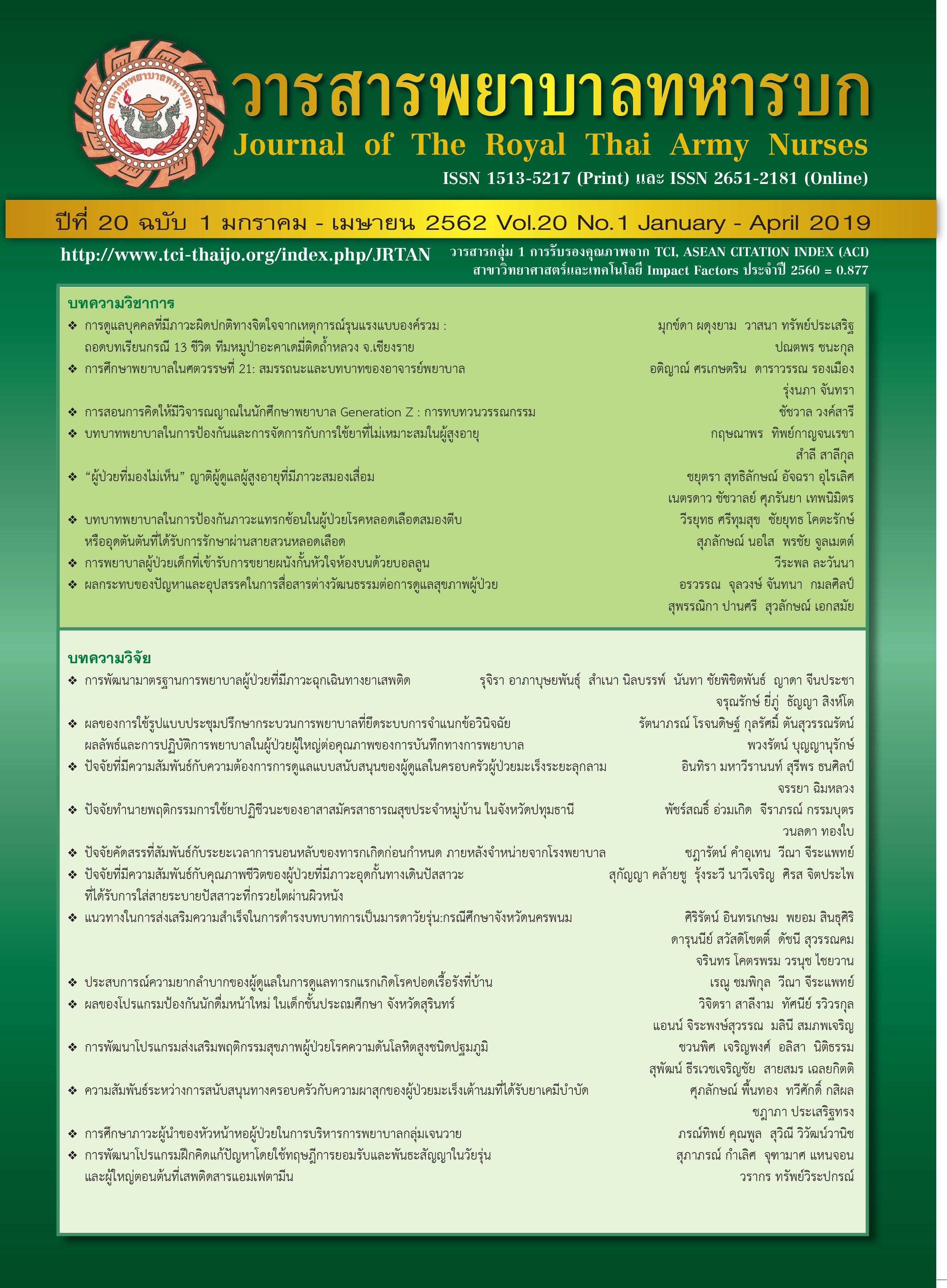Factors related to Quality of Life in Patients with Obstructive Uropathy Receiving Percutaneous Nephrostomy
Keywords:
Quality of life, Symptom experiences, Social support, Severity of skin tissue damage, Percutaneous nephrostomyAbstract
This research aimed to study the quality of life and to examine the relationships between symptom experiences, social support, severity of skin tissue damage and quality of life in patients with obstructive uropathy receiving percutaneous nephrostomy. Ninety-five participants using simple random sampling technique from those who had been diagnosed with obstructive uropathy due to pelvic malignancies receiving percutaneous nephrostomy more 3 months when who came to tertiary hospitals in Bangkok for their follow-up care and change percutaneous nephrostomy. Data were collected by using 5 parts of questionnaires: (1) Patient’s demographic data and treatment record forms, (2) The quality of life index, (3) The symptom experience assessment scale, (4) Social support questionnaire and (5) The skin assessment tool. Content validity was examined by five experts. Internal consistency reliability for the second, the third and the fourth parts of the questionnaires tested by Cronbach’s alpha coefficient were 91, .91 and .93, respectively. The skin assessment tool tested by inter-rater reliability was .90. Descriptive statistics, Pearson’s correlation and Spearman rank correlation coefficient were used in data analysis. The finding showed that the quality of life in the participants were at a moderate level (Mean = 66.34, SD = 14.55). Symptom experiences and severity of skin tissue damage were negatively related to the quality of life with statistical significance (r = -.54, r = -.35, respectively; p<.05). Social support was positively related to the quality of life with statistical significance (r = .27, p<.05).
Downloads
References
Dagli M, Ramchandani P. Percutaneous Nephrostomy: Technical Aspects and Indications. Semin Intervent Radiology. 2011;28(4):424-37.
Zhu GG, Bahrami RS. Diagnosis and Management of Obstructive Uropathy in the Setting of Advanced Pelvic Malignancies. Journal of Nephrology Research. 2015;1(3):90-6.
Ashmore AE, Thompson CJ. Pyelonephritis and obstructive uropathy: a case of acute kidney injury. BMJ case reports. 2016.
Regalado SP. Emergency Percutaneous Nephrostomy. Seminars in Interventional Radiology. 2006;23(3):287-94.
Padilla GV, Grant MM. Quality of life as a cancer nursing outcome variable. Advances in Nursing Science. 1985;8(1):45-60.
Phutthisaraseth A, Danaidutsadeekul S, Thosingha O, Phinthusophon K. Factors Associated with Quality of Life of Prostate Cancer Patients Following Radical Prostatectomy. Journal of The Royal Thai Army Nurses. 2017;18(3): 100-6. (in Thai)
Mourmouris PI, Chiras T, Papatsoris AG. Obstructive Uropathy: From Etiopathology to Therapy. World Journal of Nephrology and Urology. 2014;3(3):1-6.
Ritz VG, Speroni KG, Walbridge D. Reducing Complications and Hospitalizations Through an Innovative Catheter Care Clinic for Percutaneous Nephrostomy Catheter Patients. Journal of Radiology Nursing. 2016; 35(4):275-80.
Kaskarelis IS, Papadaki MG, Malliaraki NE, Robotis ED, Malagari KS, Piperopoulos PN. Complications of percutaneous nephrostomy, percutaneous insertion of ureteral endoprosthesis, and replacement procedures. Cardiovascular and interventional radiology. 2001;24(4):224-8.
Romero FR, Broglio M, Pires SR, Roca RF, Guibu IA, Perez MD. Indications for percutaneous nephrostomy in patients with obstructive uropathy due to malignant urogenital neoplasias. International braz j urol. 2005;31(2):117-24.
Mudegoudar S, Padasalagi GR, Ths R, Ranjan R, Joshi S. Does Urinary Diversion Improve The Quality of Life in Obstructive Uropathy Secondary to Advanced Pelvic Malignancy. J Evid Based Med Healthc. 2016;3(18):723-7.
Bigum LH, Spielmann ME, Juhl G, Rasmussen A. A qualitative study exploring male cancer patients’ experiences with percutaneous nephrostomy. Scandinavian Journal of Urology. 2015;49(2):162-8.
Ittipongwat T, Danaidutsadeekul S, Thosingha O, Amornvesukit T. The Relationships among Self-esteem, Social Support, Severity of Skin
Complication, Urinary Diversion Type and Quality of Life in Long term Urinary Diversion Patients. Journal of Nursing Science. 2013;31(1):29-37. (in Thai)
Dodd M, Janson S, Facione N, Faucett J, Froelicher ES, Humphreys J, et al. Advancing the science of symptom management. Journal of advanced nursing. 2001;33(5):668-76.
Rattanakanlaya K, Nanasilp P, Vuttanon N. Quality of life of bladder cancer patients undergoing urinary diversion. The Journal of Faculty of Nursing Burapha University. 2010; 18(2):34-50. (in Thai)
Decha W, Navicharern R. Predicting Factors of Quality of life among Colorectal Cancer Patients with Colostomy Receiving Chemotherapy Kuakarun Journal of Nursing. 2016;23(1):133-47. (in Thai)
Portenoy RK, Thaler HT, Kornblith AB, Lepore JM, Friedlander-Klar H, Kiyasu E, et al. The Memorial Symptom Assessment Scale: an instrument for the evaluation of symptom prevalence, characteristics and distress. European Journal of Cancer. 1994;30(9): 1326-36.
Khawanmuang R. Pressure ulcer risk assessment in patients with limited activity. Bangkok: Mahidol University; 2001. (in Thai)
Saritapirak S. The relationships between personal factors marital relationship selfesteem and perception of body image in pregnant women.
Bangkok: Mahidol University; 2008. (in Thai)
House JS, Kahn RL, McLeod JD, Williams D. Measures and concepts of social support. Cohen S, Syme SL, editors. San Diego, california, United States: Academic Press; 1985.
Downloads
Published
How to Cite
Issue
Section
License
บทความหรือข้อคิดเห็นใดใดที่ปรากฏในวารสารพยาบาลทหารบกเป็นวรรณกรรมของผู้เขียน ซึ่งบรรณาธิการหรือสมาคมพยาบาลทหารบก ไม่จำเป็นต้องเห็นด้วย
บทความที่ได้รับการตีพิมพ์เป็นลิขสิทธิ์ของวารสารพยาบาลทหารบก
The ideas and opinions expressed in the Journal of The Royal Thai Army Nurses are those of the authors and not necessarily those
of the editor or Royal Thai Army Nurses Association.






